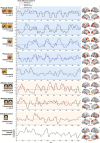Inter-subject phase synchronization differentiates neural networks underlying physical pain empathy
- PMID: 32128580
- PMCID: PMC7304508
- DOI: 10.1093/scan/nsaa025
Inter-subject phase synchronization differentiates neural networks underlying physical pain empathy
Abstract
Recent approaches for understanding the neural basis of pain empathy emphasize the dynamic construction of networks underlying this multifaceted social cognitive process. Inter-subject phase synchronization (ISPS) is an approach for exploratory analysis of task-fMRI data that reveals brain networks dynamically synchronized to task-features across participants. We applied ISPS to task-fMRI data assessing vicarious pain empathy in healthy participants (n = 238). The task employed physical (limb) and affective (face) painful and corresponding non-painful visual stimuli. ISPS revealed two distinct networks synchronized during physical pain observation, one encompassing anterior insula and midcingulate regions strongly engaged in (vicarious) pain and another encompassing parietal and inferior frontal regions associated with social cognitive processes which may modulate and support the physical pain empathic response. No robust network synchronization was observed for affective pain, possibly reflecting high inter-individual variation in response to socially transmitted pain experiences. ISPS also revealed networks related to task onset or general processing of physical (limb) or affective (face) stimuli which encompassed networks engaged in object manipulation or face processing, respectively. Together, the ISPS approach permits segregation of networks engaged in different psychological processes, providing additional insight into shared neural mechanisms of empathy for physical pain, but not affective pain, across individuals.
Keywords: affective pain; brain synchronization; inter-subject correlation; pain empathy; physical pain.
© The Author(s) 2020. Published by Oxford University Press.
Figures


References
Publication types
MeSH terms
Grants and funding
LinkOut - more resources
Full Text Sources
Medical

